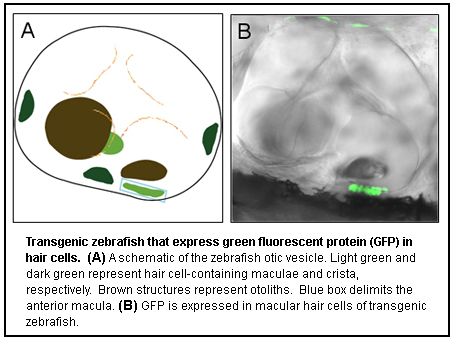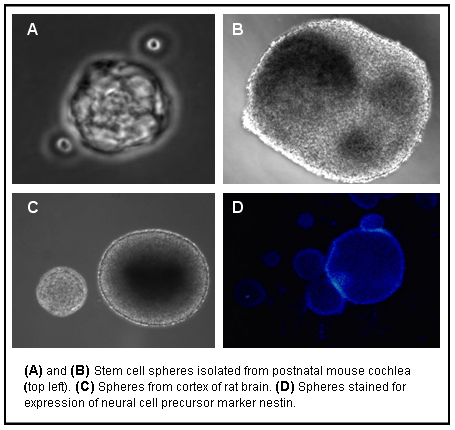Hair Cell Biology & Regeneration
Hair Cell Biology
The hair cell is an exceptionally sensitive and alacritous mechanoreceptor that is essential not only for hearing but also for balance and for the detection of water movement by aquatic vertebrates. This receptor represents mechanical stimuli as electrical responses that are relayed to the brain. Physiologically, hair cells are very well understood and much is known about how they function in hearing. However, to understand the molecular basis of hearing, the genes expressed in the hair cell must be identified and their role in hearing evaluated. Researchers in the Department of Otolaryngology at Case Western Reserve University have developed a functional genomics approach involving the zebrafish ( Danio rerio ) model system that utilizes DNA oligonucleotide microarrays and reverse genetics. This research is focused on three aspects of the hair cell: hair-bundle morphogenesis and operation, hair-cell innervation, and ribbon synapse formation and function. These studies additionally integrate imaging, physiological, transgenic, and behavioral approaches to study the hair cell.

Personnel Involved
PI: Brian McDermott, Jr., PhD
Research Assistant: Megan West, BS
Regeneration
Age, drugs, noise and genetic factors cause hearing impairment due to hair cell damage. Since the hair cells in the cochlea do not regenerate, hearing loss is permanent in most cases. Two approaches can be proposed to bring about hair cell regeneration in the laboratory mouse. If successful in mouse, this approach can be applied to humans. The first approach would be to demonstrate the presence of hair cell precursors in the adult organ of Corti, and to attempt to 'coax' them in vivo to become hair cells. The second approach would be to take hair cell precursors (grown in culture) and transplant it into the adult cochlea. The latter would be more like hair cell replacement and it does not depend on the presence of pre-existing hair cell precursor or cochlear stem cells. For both approaches, however, we do not know much about the nature of the hair cell precursors. Therefore, current effort in the program is aimed identifying cells in the mouse prenatal and early postnatal cochlea that would give rise to sensory hair cells.

Personnel Involved
PI: Kumar Alagramam, Ph.D.
Research Assistant: Daniel Chen
Research Assistant: Lauren Kisley, B.S.
Collaborators
Robert Miller, Ph.D. (Department of Neurosciences, CWRU)
Research Assistant: Lianhua Bai


